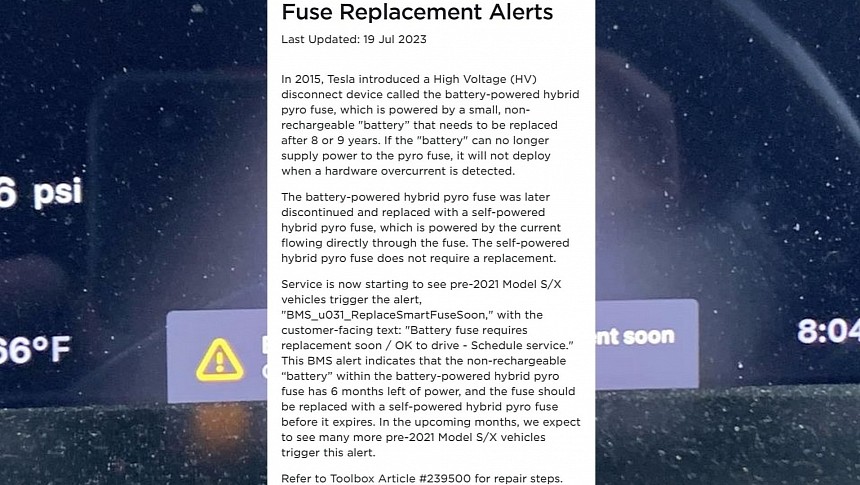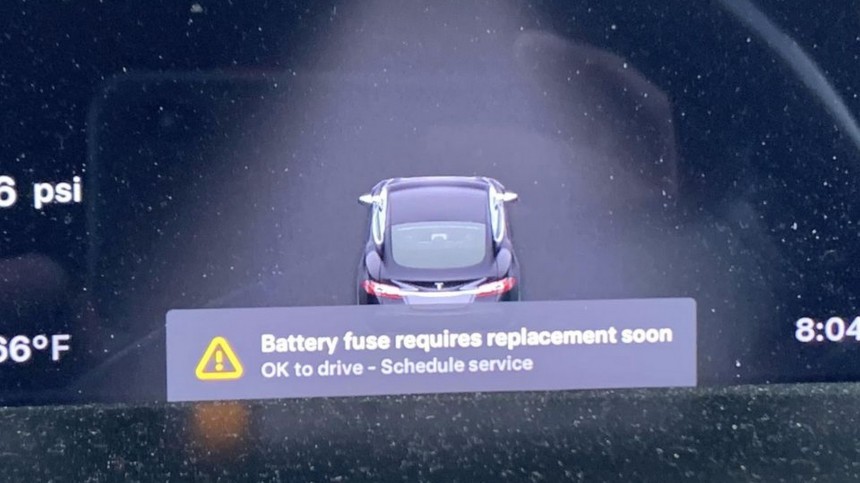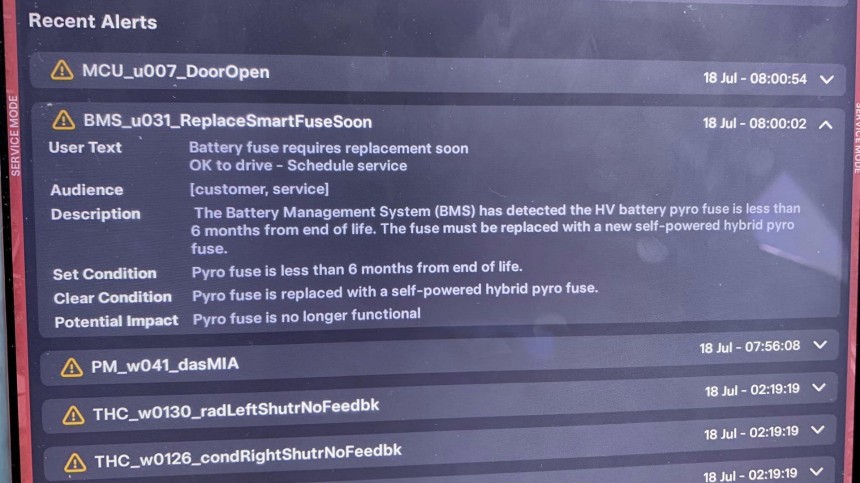I have been writing for a while already about Tesla codes that warn owners their battery packs, and their budgets are toast. Called BMS_u029 and BMS_u018, they are emerging in Model S units that get their MCUs recalled or replaced and also after some over-the-air (OTA) upgrades). Some of the same Tesla customers are now getting another error code: BMS_u031. This one warns about the need to replace the pyrotechnic battery pack fuse.
You will probably remember that Tesla performed a recall to replace a similar component on Model 3 and Model Y units in June. However, this story is a bit different. The Model S once had a pyro fuse that had its own battery. This non-chargeable cell had a lifespan of around eight or nine years. Although the Model S was released in 2012, this pyro fuse started being installed in battery packs in 2015. It is not clear which sort of high voltage disconnect device the battery packs used before that. That means several cars are now getting the BMS_u031 error code. The difference is that this was totally predictable.
The error code shows up on the screen as "BMS_u031_ReplaceSmartFuseSoon." Service Mode clarifies that the Battery Management System detected the pyro fuse battery will die in less than six months and that the vehicle is ok to drive but that the component should be replaced as soon as possible. The risk is that it "will not deploy when a hardware overcurrent is detected." In other words, it may not be able to prevent the battery pack from frying should anything go wrong.
An internal document that leaked dated July 19, 2023, states Tesla Service Centers are "now starting to see pre-2021 Model S/X vehicles trigger the alert." That matches precisely the lowest lifespan the pyro fuse battery was expected to have. The document also clarifies that Tesla adopted another disconnect device a while later. Just like the component that preceded the dying pyro fuses, there is no information about when the BEV maker started using the new part.
This new "self-powered hybrid pyro fuse" gets juice from "the current flowing directly through the fuse" and does not need to be replaced unless it deploys for any reason, but that is also expected. The surprise here is having a fuse powered by its own cell.
This is raising heated discussions in Tesla groups on Facebook. Some of the owners who had the BMS_u031 got it covered under warranty. Others want the same treatment, arguing that these components are wear parts and that Tesla should have replaced them when it came up with the new design. The usual Tesla advocates say this is absurd and the company bears no responsibility for swapping the pyro fuse.
Customers affected by the issue are receiving different estimates, as a Tesla Motors Club (TMC) forum thread shows. Some of them paid less than $300 for the service, while others had to pay more than $700. One owner even claimed having received an estimate of more than $11,000, but that must have been a mistake. The pyro fuse costs around $100. It is the levels of difficulty getting the job done that may make it more costly. According to the discussions, that has to do with two kinds of battery packs. Those that have the fuse box on the top get the more expensive repair bills. Newer ones have the disconnect device at the bottom, which does not require removing the battery pack to replace it. This is the most recent example of how Tesla vehicles are not designed with repairability in mind, even with a component that would so obviously need to be replaced.
One case suggests that these warnings are all being triggered at the same time regardless of the battery pack the vehicles present. A TMC participant said their 2015 Model S P85D had its 400V, 85-kW accumulator replaced with "a new generation, 350V, 90-kW pack" less than three months ago. The car was also upgraded to a P90D after receiving the new component, which really honors the adjective. Unlike most battery pack replacements, it is not remanufactured: it is brand new (1014116-00-C), which implies it already has the self-powered pyro fuse that does not have its own battery.
Why did this customer receive the message that the disconnect device has to be replaced if it probably does not use it? Could it be something a recent OTA update imposed instead of a true BMS diagnostic of the pyro fuse's battery? Only specialists such as Jason Hughes (the Tesla Hacker) and other independent shops that work with these BEVs will be able to answer that. It may also be the case that even these folks have no clue what is going on with the BMS_u031. Considering how many people are getting the error code and how this is starting to invade Tesla forums, we should have those answers soon.
The error code shows up on the screen as "BMS_u031_ReplaceSmartFuseSoon." Service Mode clarifies that the Battery Management System detected the pyro fuse battery will die in less than six months and that the vehicle is ok to drive but that the component should be replaced as soon as possible. The risk is that it "will not deploy when a hardware overcurrent is detected." In other words, it may not be able to prevent the battery pack from frying should anything go wrong.
An internal document that leaked dated July 19, 2023, states Tesla Service Centers are "now starting to see pre-2021 Model S/X vehicles trigger the alert." That matches precisely the lowest lifespan the pyro fuse battery was expected to have. The document also clarifies that Tesla adopted another disconnect device a while later. Just like the component that preceded the dying pyro fuses, there is no information about when the BEV maker started using the new part.
This is raising heated discussions in Tesla groups on Facebook. Some of the owners who had the BMS_u031 got it covered under warranty. Others want the same treatment, arguing that these components are wear parts and that Tesla should have replaced them when it came up with the new design. The usual Tesla advocates say this is absurd and the company bears no responsibility for swapping the pyro fuse.
Customers affected by the issue are receiving different estimates, as a Tesla Motors Club (TMC) forum thread shows. Some of them paid less than $300 for the service, while others had to pay more than $700. One owner even claimed having received an estimate of more than $11,000, but that must have been a mistake. The pyro fuse costs around $100. It is the levels of difficulty getting the job done that may make it more costly. According to the discussions, that has to do with two kinds of battery packs. Those that have the fuse box on the top get the more expensive repair bills. Newer ones have the disconnect device at the bottom, which does not require removing the battery pack to replace it. This is the most recent example of how Tesla vehicles are not designed with repairability in mind, even with a component that would so obviously need to be replaced.
Why did this customer receive the message that the disconnect device has to be replaced if it probably does not use it? Could it be something a recent OTA update imposed instead of a true BMS diagnostic of the pyro fuse's battery? Only specialists such as Jason Hughes (the Tesla Hacker) and other independent shops that work with these BEVs will be able to answer that. It may also be the case that even these folks have no clue what is going on with the BMS_u031. Considering how many people are getting the error code and how this is starting to invade Tesla forums, we should have those answers soon.








